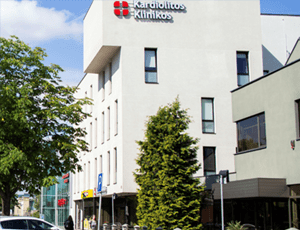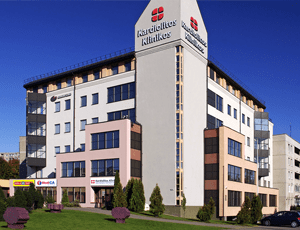Treatment cost

Apart from in-detail treatment procedures available, Kardiolita Hospital, Kaunas located in Kaunas, Lithuania has a wide variety of facilities available for International Patients. Some of the facilities which are provided by them are Accommodation, Airport Transfer, Choice of Meals. Also listed below are some of the most prominent infrastructural details:


Kardiolita Hospital, Vilnius located in Vilnius, Lithuania is accredited by JCI. Also listed below are some of the most prominent infrastructural details:
The last part of the gastrointestinal system is referred as the colon and it is 5-6 cm long. It is ‘U’ shaped and it starts from the distal part of the small intestine and is connected to the rectum and anus. It absorbs the fluids, processes the metabolic waste products, and eliminates through the rectum and anus. The removal of the colon is called colectomy.
There are different types of colectomies such as complete colectomy, right hemicolectomy, left hemicolectomy, sigmoid colectomy, and proctocolectomy. The surgical removal of the left side of the colon (descending colon) is called left hemicolectomy surgery. The surgical removal of the cecum, ascending colon, and the hepatic flexure (right side of the colon) is called as the right hemicolectomy surgery.
Some of the conditions that require complete colectomy or hemicolectomy surgery include the following:
A hemicolectomy procedure can be performed as a laparoscopic or open surgery. The type of the surgery to be performed is decided by the surgeon during the evaluation and the decision depends on the age and the condition of the patient.
Sometimes the laparoscopic procedure can also be turned into open surgery, depending on the feasibility of the procedure with respect to safety and accuracy. Overall, the following parameters decide whether a laparoscopic or an open surgical procedure will be performed:
You will be informed by your surgeon about the type of surgical procedure that you will benefit you the most. You will be taken to the operating room, and blood pressure and breathing will be monitored.
You will be positioned in lithotomy Trendelenburg (modified Lloyd-Davis) position and your both arms will be abducted on arm boards. The legs will be placed in stirrups and soft padding will be placed underneath to prevent pressure and injuries to the skin and nerves.
After positioning, you will be given general anaesthesia so that you do not feel any pain during the procedure. Sometimes, a peripheral nerve block may also be given to control pain during and after the surgery.
You will be positioned in the supine position initially and later you may be taken to the Trendelenburg position (lying by facing upwards on a tilted bed with pelvis higher than the head).
After positioning, you will be administered general anaesthesia and an additional epidural block for pain management. The catheter will be placed for monitoring the urine output during and after the procedure. The laparoscopic right hemicolectomy procedure or open surgery can be performed, depending on the condition of the colon.
During the hemicolectomy procedure, your surgeon may take any of the following approaches:
Ask your healthcare adviser for the best multiple options and choose the one that meets your expectations
Different hospitals have different pricing policy when it comes to the cost of Hemicolectomy in Kaunas. Some of the best hospitals for Hemicolectomy offer a comprehensive package that covers the end-to-end expenses related to investigations and treatment of the patient. The comprehensive Hemicolectomy package cost includes the cost of investigations, surgery, medicines and consumables. Post-surgical complications, new findings and delayed recovery may have an impact on the total Hemicolectomy cost in Kaunas.
Many hospitals in Kaunas perform Hemicolectomy. The following are some of the most renowned hospitals for Hemicolectomy in Kaunas:
While the speed of recovery may vary from patient to patient, they are still required to stay for about 16 days after discharge. This duration of stay is recommended to complete all the necessary follow-ups and control tests to ensure that the surgery was successful.
Kaunas is considered to be one of the best places for Hemicolectomy in the world. This is because of the availability of some of the best doctors, advanced medical technology and good hospital infrastructure. there are a select few destinations that provide comparable quality of healthcare for the procedure. Some of such cities are:
Apart from the Hemicolectomy cost, there are a few other daily charges that the patient may have to pay. These charges may vary from 50 USD per person.
The average duration of stay at the hospital after Hemicolectomy is about 5 Days for proper care and monitoring. During the recovery, the patient is carefully monitored and control tests are performed to see that everything is okay. If required, physiotherapy sessions are also planned during recovery in hospital.
There are more than 1 Hospitals that offer Hemicolectomy in Kaunas. These hospitals have proper infrastructure for the treatment of patients who require Hemicolectomy. Such hospitals follow all legal protocols and guidelines as specified by the local medical affairs body when it comes to the treatment of international patients.